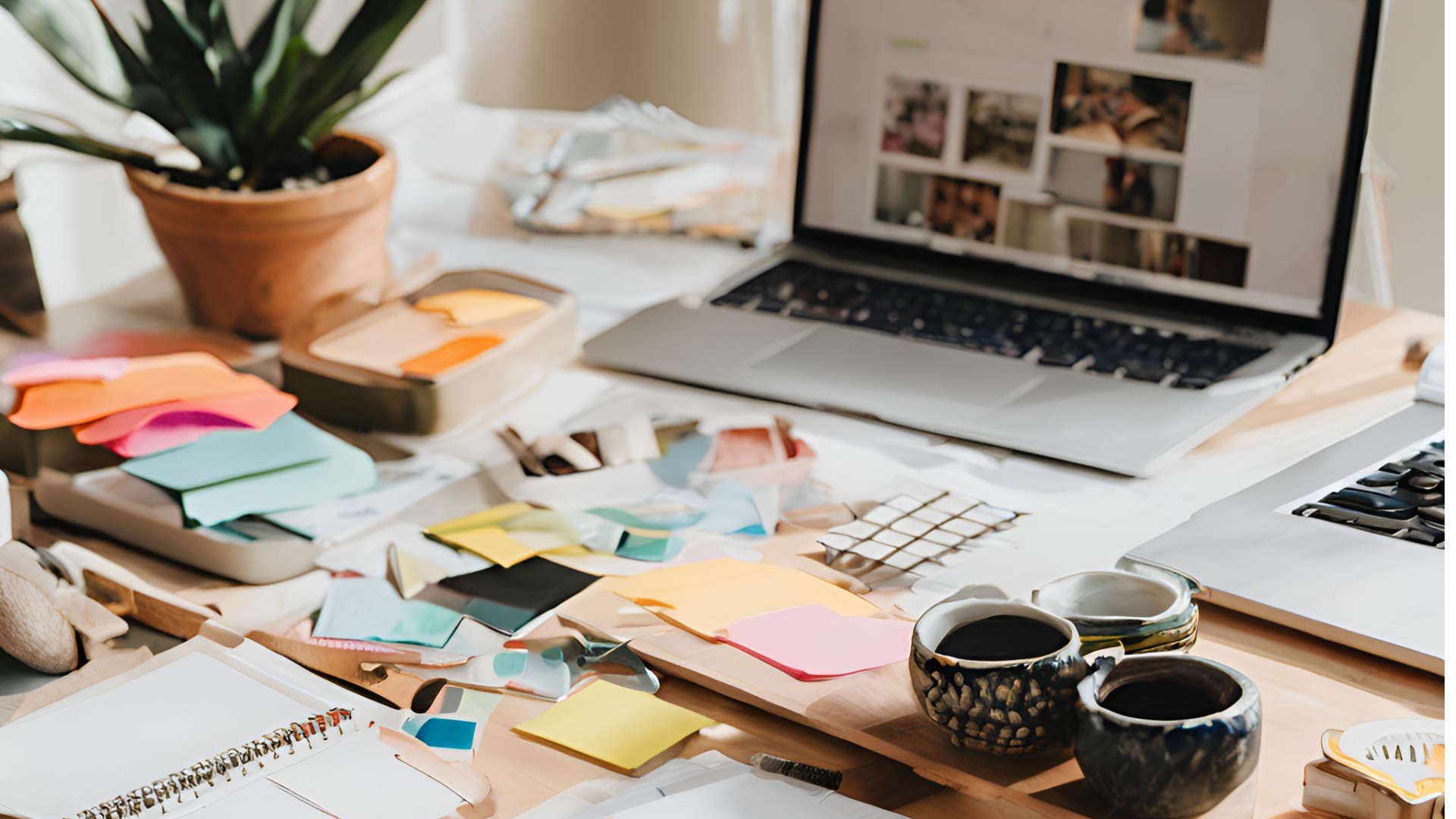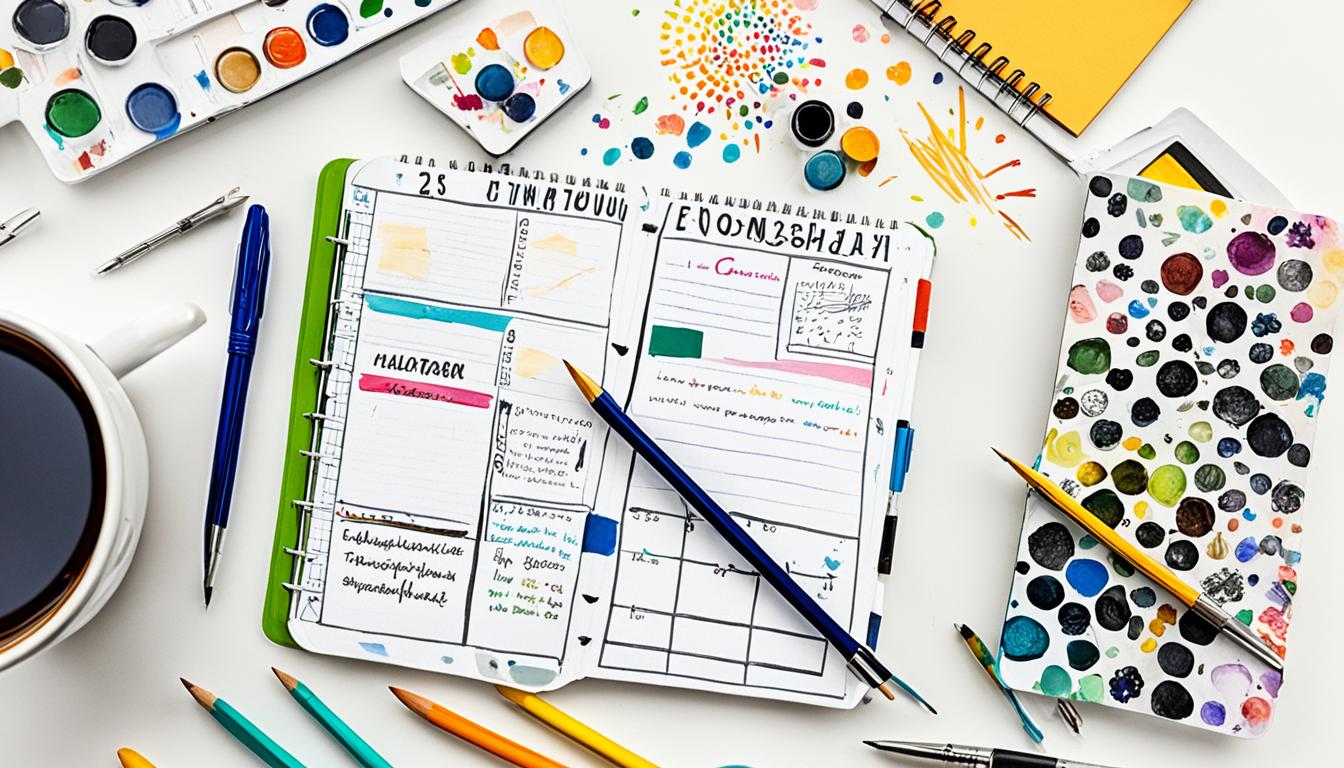Creativity is not always about working from nine to five. Artists and those in creative fields find it hard to manage their time. They often get stuck on small tasks, leaving big projects aside. Time management for artists is key to turn dreams into achievements.
Everyone gets 24 hours a day, but creatives may not use them wisely. They risk falling behind on important work. With the right strategies, artists can use their time better and get more done. This leads to reaching their goals faster and easier.

Establish a Structured Schedule
People who create things do well with a mix of planned and unplanned time. It’s key to set a routine that boosts this balance. You should know the times of day you work best. Then, use these hours for your most important work.
Finding Your Most Productive Hours
Studies say most folks can’t do hard, creative work for more than four hours every day. Find out when you’re most on the ball. This can really boost what you get done. Watching how your energy changes every half-hour is a smart idea. It shows you the times you’re at your creative peak.
Using Time Blocks Effectively
Blocking out your time can help you get a lot done. People who make a lot of stuff keep certain times just for creating. They make sure no one bothers them during these times. It’s also good to take short breaks to keep your mind fresh. These breaks help keep you focused and full of energy.

Setting Boundaries for Uninterrupted Work
It’s important to tell others when you’re trying to focus. Let friends and family know you can’t be disturbed at certain times. These quiet times are great for really diving into your work. Also, do similar tasks all at once, like answering emails. This helps keep your creative vibe strong.
Eliminate Distractions
Artists and creators face distractions like social media and alerts. To fight these, they should point out and stop common distractions. Doing so helps create a focus-friendly and distraction-free zone. This setting is key to keeping the creative juices flowing.
Identifying Common Distractions
Distraction happens when something pulls your mind from the main task. Today’s work culture, with its constant connectivity, makes us all more vulnerable. Things like social media, emails, and noise can really slow us down.
Utilizing Apps to Block Distracting Websites
One great way to stay focused is using productivity apps. These tools, like Freedom and StayFocusd, help block sites that distract you. They are like digital armor, protecting your work time. Entrepreneur Nir Eyal says dealing with internal triggers is key. These apps can assist with that.
Creating a Dedicated Workspace
Having a special place to work is very important. It should be neat and free from distractions. This setup helps keep work and play separate. It’s a strategy followed by greats like Mozart, who benefited from clear working spaces.
By using these methods, creative pros can stay focused and work better. This leads to top-notch results and a smoother work process.
Prioritize Your Tasks
Learning how to rank tasks is crucial for artists and other creators. By using to-do lists and the ABC method for setting top priorities, they manage their time better. By setting realistic deadlines, they can focus on moving towards their creative goals step by step.

Using To-Do Lists Effectively
To-do lists are key for better organizing tasks. They should be short and list tasks by how important and urgent they are. Trello and Asana are great tools for this. They help keep track of everything.
The ABC Method of Prioritization
The ABC Method is a smart way to decide what to do first. It divides tasks into A, B, and C groups based on their importance. This helps creatives focus on the most critical things. Tools like the Eisenhower Matrix, based on a quote by Eisenhower, also help with this.
Setting Realistic Deadlines
Managing deadlines well is key for creators. It’s crucial to set deadlines that are doable given the project’s size and your time. Many people use Trello, which helps a lot with managing deadlines. Google Calendar is also helpful because it links tasks and deadlines, making things smoother.
If you want more advice on how to organize tasks, take a look at this guidance on prioritizing daily tasks.
Take Regular Breaks
It may sound strange, but regular breaks help keep you productive. Studies from the University of Illinois show that taking breaks can stop burnout. They can also make you more focused and creative. Taking a short break every 20-30 minutes for 5-10 minutes boosts your mental energy.

The Pomodoro Technique is great for boosting your productivity. It involves working for 25 minutes, then taking a short break. This keeps your mind fresh. Having some ‘white space’ between tasks helps you relax and get ready for the next one, leading to better productivity.
Being active during your breaks is even better. It improves your blood flow and energy. Also, going outside for a while lowers stress and makes you happier. When you take these breaks, stay away from work stuff. Relax or do something like meditation to clear your mind.
Planning your breaks ahead using a calendar or an app can make them even more effective. Having longer breaks every 2-4 hours, for 15-60 minutes, is good for a bigger mental recharge. Use these times to do things that matter to you. That way, you can keep your creative energy high all day.
Batch Similar Tasks Together
Bunching related tasks is a smart way to boost your workflow efficiency. The American Psychological Association says doing more than one thing at a time can cut your work by 40%. By using task batching, creatives can make their work smoother. This way, they avoid the delay caused by jumping between tasks.
Studies at the University of California, Irvine, show it takes 23 minutes and 15 seconds to get back to work after a distraction. That’s why it’s so important to keep interruptions low, which task batching helps with. When you group similar tasks, it’s easier to focus deeply and solve problems creatively. This leads to better results.
Task batching also saves your brain from overwork by cutting down on multitasking. It boosts your focus, concentration, and saves time. This way, you avoid doing too much at once and feeling overwhelmed. It keeps your workload in check.
By working in batches, you also reduce the chances of getting burnt out. High cortisol levels from changing tasks too often can lead to burnout. But, with tasks organized this way, you cut down on interruptions. This lets you keep up your productivity and enjoy your work. Taking short breaks between batches can also keep you feeling fresh and motivated.
In the end, task batching makes your workflow better. It helps you manage your time well and get more done. With your day planned around related tasks, you make fewer decisions and feel more in control. This makes your workday more efficient and enjoyable.
Say No to Non-Essential Requests
Learning to say no is crucial for creative people. It’s about managing your time well. By doing this, they can focus on important tasks and say no to things that don’t matter. This way, they have more time for what’s really important.
Dan Kennedy talks about sorting requests. They can be about taking time or adding value. If there are too many unimportant requests, you must decide carefully. Derek Sivers believes that if you’re not really excited about something, you should probably say no. This helps focus on what truly matters.

With more than ten years in business and project management, the author knows the value of saying no. This means choosing only the most important things. Working without distractions and in short bursts can make someone more productive. It also helps focus on tasks that bring in money.
Struggling with distractions, setting clear goals, and estimating time are common for creatives. However, focusing on what’s essential and managing time well can solve these issues. This leads to better work and more satisfaction with their work.
By saying no to less important things, creatives free up their time. This allows them to grab new, better chances. Ultimately, they can make the most of their skills and opportunities.
Track Your Time Usage
Keeping track of how you spend your time is very important. It helps you see how you work and can make your schedule better. By looking closely at how you use your time, you can see what you do well and what wastes time.
Tools like Workamajig and Timely can help you with this. They help you see where your time goes. This makes it easier to use your time well and get more done.
Using Time Tracking Tools
Workamajig has tools that work with projects. These include timers and a way to stop and start tasks. It also can add your schedule to a calendar. Workamajig is great for people like artists and marketers. It helps them with their money and how they use their time.
Timely is special because it uses AI to track your time. It watches what you do without bothering you. This can help make you more focused. Timely also helps with making reports and showing your progress on tasks that don’t cost money.
Identifying Patterns in Your Work Habits
The information from time tracking can show you how you work. It can show what you’re good at and what you need to work on. Seeing this can help you change your day to be better. You can avoid things that stop you from working well.
Adjusting Your Schedule Based on Insights
With this data, you can make your schedule work better for you. For example, you might find you work best at some times more than others. You can then plan your day to fit those times.
Tools like Workamajig show your project’s progress clearly. This can help you know what to do first. It makes handling your work easier and more organized. This can make your day at work better and more satisfying.
Utilize Time Management for Creatives
Time management is more than rules; it’s a toolbox for creatives. These tools help balance creativity and daily life. They turn chaos into a peaceful blend of work, fun, and creation.
According to Daniel Pink, afternoons are prime for creative sparks, following our body’s clock. Questlove sees listening to music as a creative step. This shows our minds connect with the time and rhythm, boosting our creativity.

Research suggests creative folks do about four solid hours of work a day. Sleep, breaks, and walking help boost their creative game. They prove that rest is actually part of being productive.
Analyzing great creators’ schedules finds them setting aside time for their art. Focusing on one project means more achievements and happiness.
Being clear about when to work on our art keeps us on track. Kevin Kruse’s book points out multitasking kills creativity. It’s better to group similar tasks for max efficiency.”>
Conclusion
Mastering time management changes how creatives reach their dreams. It starts with making a good schedule and learning to say ‘no’ wisely. By avoiding common distractions like social media and emails, you can work more efficiently.
Freelancers often struggle with finishing work on time. They deal with many clients and new projects at once. It helps to set achievable goals and work on them step by step.
Use a bit of time every day for work on social media and other tasks. This practice can help you be more successful. Knowing what to prioritize and saying ‘no’ to less important things keeps your work fresh and focused.
Working with others who have different skills can make your work go faster. It’s vital to balance staying inspired with meeting deadlines. Following these steps will help you manage your time better and succeed in your creative work.
FAQ
What are the best productivity strategies for creatives?
For creatives, great productivity involves establishing a tight schedule. It’s also key to cut out distractions and focus on important tasks. Don’t forget to take breaks to stay refreshed.
How can I find my most productive hours for creative work?
Notice when you feel most alert to find your best work hours. Try working at different times to see what works best for you. This helps figure out your peak creative times.
What are time blocks and how do they help with time management?
Time blocks are specific periods you set aside for tasks or projects. They allow for deep focus on one thing at a time. This focus boosts your creativity and productivity.
How can I set boundaries to ensure uninterrupted work time?
Set hard limits on your creative time. Make this time just as important as any other commitment. By doing so, you reduce distractions and boost your focus.
What are common distractions for creatives and how can I eliminate them?
Social media, constant emails, and unrelated tasks are big distractions. Use apps to block distracting websites. Set specific times to check social media and email.
How can productivity apps help in blocking distracting websites?
Apps like Freedom and StayFocusd can block time-wasting sites. They keep you from losing focus on your work. This keeps you on track and productive.
What makes a dedicated workspace effective?
Dedicate a space just for your creative work. It should be free of distractions. This area helps signal your brain that it’s time to focus.
Why is prioritizing tasks important for creatives?
It’s crucial for creatives to focus on important tasks first. Using lists and the ABC method helps manage your time. This way, you avoid getting overwhelmed or putting things off.
How do I use the ABC method of prioritization?
With the ABC method, you categorize tasks from important (A) to not as much (C). Start with ‘A’ tasks, then move to ‘B’ and ‘C’. This method keeps you focused on what’s essential.
What are realistic deadlines and how do they help with time management?
Realistic deadlines are key to getting things done without stress. They keep you from overworking. Plus, they make long projects seem doable in short steps.
Why are regular breaks important for creatives?
Breaks recharge your mind and prevent burnout. They’re essential for boosting creativity. Resting your mind helps with problem-solving and new ideas.
What is task batching and how does it improve workflow efficiency?
Task batching is when you do similar tasks together. It cuts down on the time and mind power needed to switch between tasks. This method makes your work flow smoother.
How can I learn to say no to non-essential requests?
Say ‘no’ to things that don’t fit your main goals. Politely turn down tasks that sidetrack you. This keeps your focus sharp on what truly matters.
How do time tracking tools enhance productivity for creatives?
Tools like Toggl and RescueTime let you see how you use your time. With this data, you can find the best times to work. It helps you focus when it matters most.
What are the benefits of conducting a time audit?
A time audit shows where your time really goes. It highlights what use of time helps you and what doesn’t. By knowing this, you can adjust for better productivity.
How can effective time management improve artistic productivity?
Managing time well means more art without losing quality. It also ensures you have time for rest and personal growth. Balancing work and life is key to staying creative.

More Posts
15 Productivity Factors That Seriously Affect Productivity
Have you been struggling with your productivity at work lately? Here are 15 factors you should know about that can significantly affect your productivity. Enhanced productivity is something many organizations look for in...
Sneak peek: Quarter goals and big rocks planning
8 Tips to Organize a Wonderful Monthly Dinner Party
Hosting a dinner party makes a monthly get-together special for friends. It makes them feel valued. Following these tips will make your gathering fun and engaging. Start by getting your home ready to...
9 Innovative Ways of Working to Boost Productivity
Productivity is more than just doing tasks. It's about how well and efficiently employees help reach company goals. This makes the company stronger and more profitable. Finding new ways to make employees more...